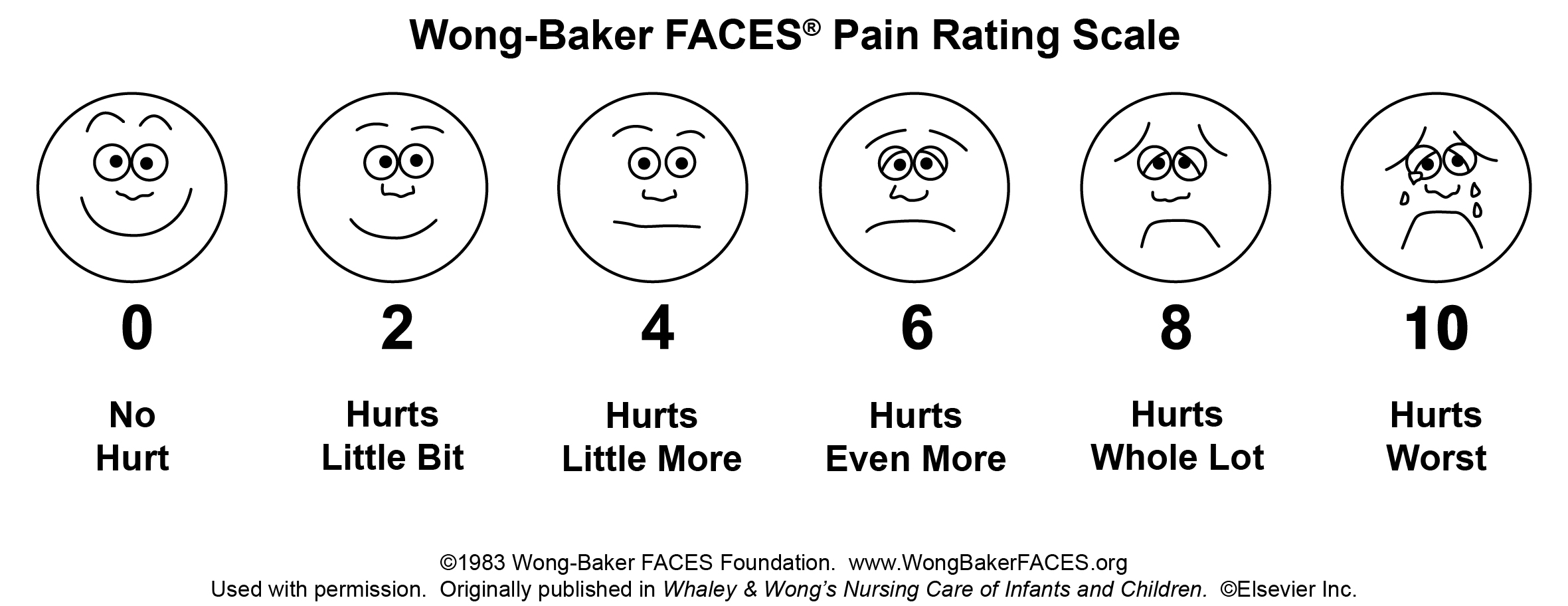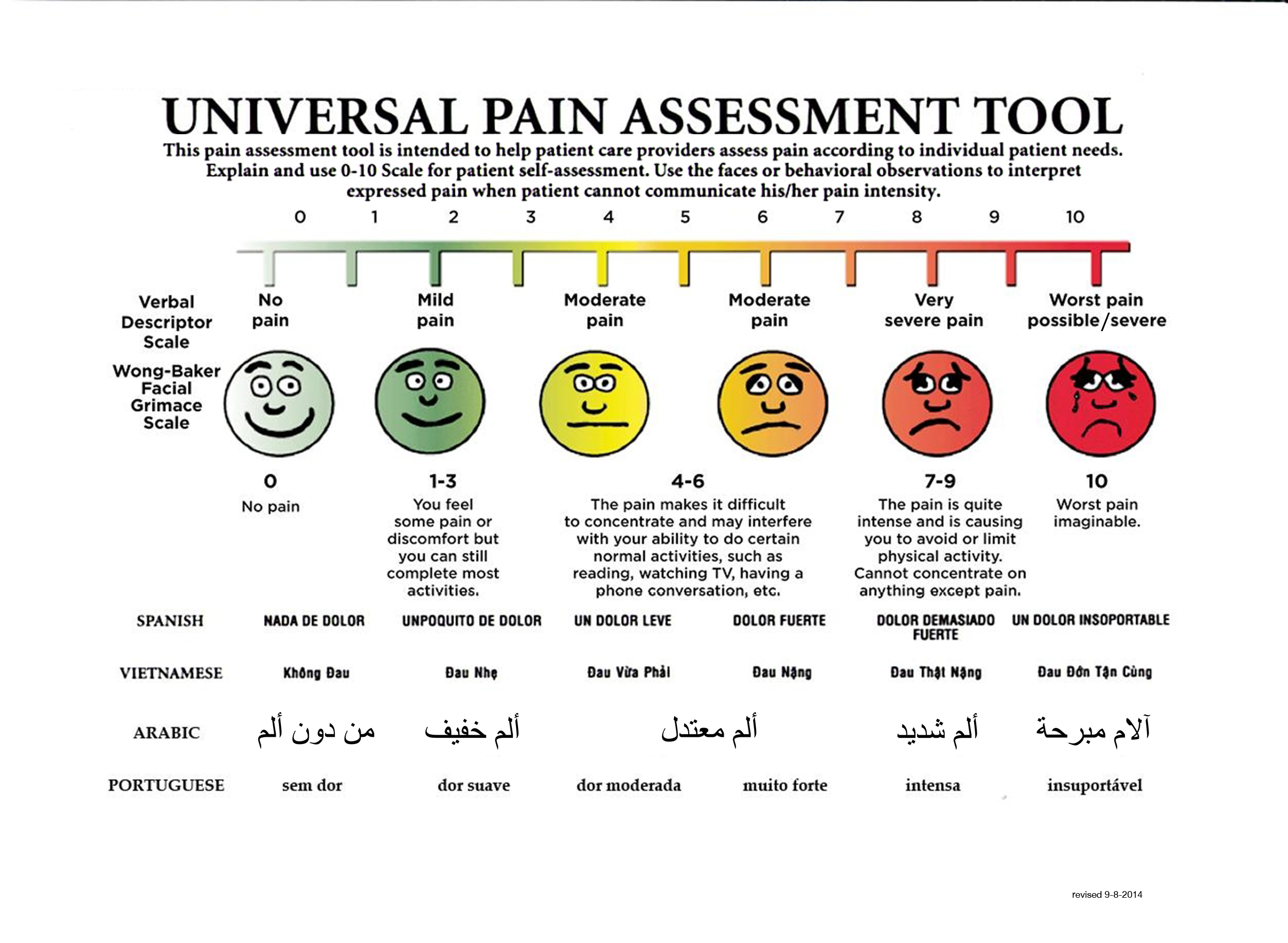Faces Pain Scale Printable
Faces Pain Scale Printable - The nurse, nursing assistant or child life specialist can help you choose the best tools and show you how to use them. The face on the left shows no pain. It shows six faces with different levels of pain, from 0 to 10, and can be. The emotional faces range from smiling to grimacing. Point to each face using the. Find out the difference between the original and revised versions,. Rating scale is recommended for persons age 3 years and older. Web learn about the faces scale, a tool for children and adults to communicate their pain level. Point to each face and say the words under the. Usual tone & motion to limbs uneasy, restless, tense;. Translation and adaptation for use in many cultures. Web choose the face that best describes how he is feeling. It shows six faces with different levels of pain, from 0 to 10, and can be. Children match their level of pain. Nonexpressive legs normal position or relaxed; Infants should be observed for one minute in order to fully assess each indicator. Web the faces pain scale shows reliability and consistency when pain ratings are assigned by children, especially as they are associated with related pain experiences. Development, initial validation and preliminary investigation for ratio scale. Children match their level of pain. It shows six faces with different. Web the faces pain scale shows reliability and consistency when pain ratings are assigned by children, especially as they are associated with related pain experiences. Web explain to the person that each face is for a person who feels happy because he has no pain (no hurt) or sad because he has some or a lot of pain. Point to. Web my pain rating scale* explain to your child that each face is for a person who has no hurt (pain) or some or a lot of hurt (pain). Translation and adaptation for use in many cultures. Face 4 hurts a little more. Usual tone & motion to limbs uneasy, restless, tense;. Adults and children (> 3 years old) in. Face 0 doesn’t hurt at all. Web explain to the person that each face is for a person who has no pain (hurt) or some, or a lot of pain. Children match their level of pain. It shows six faces with different levels of pain, from 0 to 10, and can be. Explain to the person that each face is. Face 0 doesn’t hurt at all. Nonexpressive legs normal position or relaxed; Face 4 hurts a little more. Usual tone & motion to limbs uneasy, restless, tense;. Video now availablecurated by expertsintegrated in adobe apps Infants should be observed for one minute in order to fully assess each indicator. Face 4 hurts a little more. The emotional faces range from smiling to grimacing. Face 2 hurts just a little bit. Face 4 hurts a little. Adults and children (> 3 years old) in all patient care settings. Usual tone & motion to limbs uneasy, restless, tense;. The scale uses five faces to represent different. Web learn about the faces scale, a tool for children and adults to communicate their pain level. Web see the nips scale for the description of infant behavior in each indicator. Explain to the person that each face is for a person who feels happy because he has no pain (no hurt) or sad because he has some or a lot. Web the scale consists of six faces that range from no pain at all to the worst pain imaginable. The scale uses five faces to represent different. Poster, 6th international. Adults and children (> 3 years old) in all patient care settings. Web explain to the person that each face represents a person who has no pain (hurt), or some, or a lot of pain. The emotional faces range from smiling to grimacing. Face 0 doesn’t hurt at all. Infants should be observed for one minute in order to fully. Adults and children (> 3 years old) in all patient care settings. It shows six faces with different levels of pain, from 0 to 10, and can be. Face 2 hurts just a little bit. Access the scale, order products, listen to podcasts, and read a book. Point to each face and say the words under the. Web my pain rating scale* explain to your child that each face is for a person who has no hurt (pain) or some or a lot of hurt (pain). The face on the left shows no pain. Face 2 hurts just a little bit. Face 0 is very happy. Explain to the person that each face is for a person who feels happy because he has no pain (no hurt) or sad because he has some or a lot. Web see the nips scale for the description of infant behavior in each indicator group. Web learn about the faces scale, a tool for children and adults to communicate their pain level. Nonexpressive legs normal position or relaxed; Web explain to the person that each face is for a person who feels happy because he has no pain (no hurt) or sad because he has some or a lot of pain. Face 4 hurts a little more. Video now availablecurated by expertsintegrated in adobe apps
Printable Faces Pain Scale Chart

Printable Faces Pain Scale Chart

Faces pain rating scale. Comparative pain scale chart. Pain assessment

Printable Pain Scale Faces

110 Pain Chart Faces

Printable Faces Pain Scale

Printable pain scale faces 1 10 delightvsa

Printable Pain Scale Faces

Printable Faces Pain Scale Chart
FACES PAIN SCALE.pdf Breathing Apnea
Web Explain To The Person That Each Face Is For A Person Who Has No Pain (Hurt) Or Some, Or A Lot Of Pain.
Point To Each Face Using The.
Development, Initial Validation And Preliminary Investigation For Ratio Scale.
The Emotional Faces Range From Smiling To Grimacing.
Related Post:
